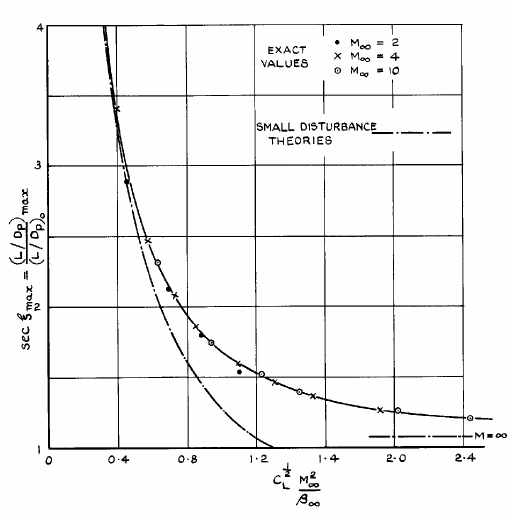
This report demonstates a technique for significantly increasing the lift to drag ratio of waveriders. The principles involved are easily understood and are explained below; the mathematics presented in the report is more difficult.
Nonweiler's original waveriders were plane shock wave caret wings. These have the property, that for a given Mach number and lift coefficient, the shock wave strength and the inviscid lift to drag ratio (L/Dp) remain the same, whatever the planform. As all the flow is deflected downwards with no sideways losses, it might be expected that these wings would have a high L/Dp. Indeed these wings were soon found to form a practical, if somewhat "leaky", upper limit to the L/Dp and to provide an excellent basis for the comparison of high performance waveriders.
Early techniques for improving the L/Dp involved reducing the shock wave losses. This was achieved by introducing isentropic compressions behind the shock wave to increase the lift. Jones cone flow based waveriders showed that there were modest gains available in this way. A more direct demonstation came from varying the anhedral of a caret wing. The caret wing is progressively flattened from its inverted V shape to a plane delta, keeping the planform and the incidence, and thus the L/Dp, the same. The shock wave bows outwards as the anhedral decreases, and the lift coefficient increases to a maximum value at an anhedral of about half that for the caret wing. Other studies giving small gains followed.
A different technique for increasing the L/Dp is introduced in the present report. Nonweiler's caret wings have a triangular or delta planform with an unswept trailing edge. Consider the same wing with a trailing edge which is swept forward one side and back on the other side so that the wing is not symmetrical. For this modified caret wing, the lift coefficient and L/Dp remain the same (for sweeps less than the Mach angle). However there is now a significant sideforce from the unbalanced pressure acting on the surface of the wing. Rotating the wing about a streamwise axis makes no difference to the wing drag. However by rotating until the sideforce is zero, the lift is increased by the squareroot of the lift squared plus the sideforce squared. That is the L/Dp is increased by this same factor. The symmetry is restored to these wings by joining mirror images to give an inverted W wing with swept trailing edges. The potential gains in the L/Dp are shown to be large and to be strongly dependant on the Mach number and lift coefficient. The quoted wing examples in RAE TM1247 have a lift coefficient of 0.057 at Mach 4 and a lift to drag ratio close to a caret wing. This lift coefficient and Mach number corresponds to a value on the horesontal axis of 1.0 in the figure below, giving a potential gain in L/Dp for W wings of 70% above that of an equivalent caret wing. For a lift coefficient of 0.057 at M=8 the gain is a more modest 25%.

Availability.
The paper is available as R&M 3623
or email J A C K @ J A C K P I K E . C O . U K
Return to J. Pike Published Papers.
Last amended: Dec 2013.